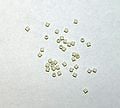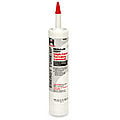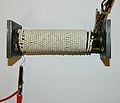This is a fully automated version of Recyclebot v.2.2 with many improved features. Some of the features are:
- Type of plastic can be selected from the keypad interface and the controller automatically updates the extrusion temperature for the plastic.
- Extrusion temperature can also be feed by the keypad interface for any type of plastic which can be melted and extruded.
- LCD interface for better process monitoring.
- No extrusion until the extrusion temperature is achieved - automatically controlled by microcontroller, with (manual option).
- Low cost power control options using Triac and MOSFET.
Part List
The complete part list can be found on this link.[1]
some of the parts were fabricated in the university workshop
Power calculations
The first step is to choose the required power for melting and extruding plastic. For Recyclebot v2.2 and Recyclebot v2.3, a maximum power level (Pmax) of 440 W was chosen on the basis of extrusion speed, size of extruder and requirements. This is to be noted that although the Pmax was chosen as 440 W, this power level is barely used; as this level is well enough to reach a temperature of 500 C almost instantaneously, therefore a very highly reliable power control system has to be used so that system remains in the bounded limits. At this maximum power level almost all types of plastic vaporize instantaneously. The system is designed to operate well below a maximum temperature of 350 C which can be feed or chosen from the keypad interface.
Variables and constants
Pmax: Maximum power
n: number of turns on the heating pipe section
d: outer diameter of the heating pipe section
Ω': resistance of nichrome wire per unit length
r: resistance of nichrome wire
L: length of nichrome wire
V: potential difference used for powering heating element (nichrome) = 110 V
I: current flowing through the heating element (nichrome)
P = V . I
=> I = P / V (This is used to select the Triac on the basis of maximum current of Triac IT(RMS))
P = I2 . r
=> r = P / I2
r = Ω' . L
=> L = r / Ω'
The length of nichrome is calculated according to the above mentioned procedure. There are two types of nichrome, bare and insulated. If insulated nichrome is used, it is to be assured that nichrome touch the metal heating section pipe throughout the length, otherwise even slight air gap between the nichrome and metal interface will trigger high temperature and nichrome will start fuming up which may be toxic in nature. Therefore it is better to use bare nichrome wire with insulated ceramic beads as shown in the picture gallery. This allow us to use higher power for extrusion and high temperature operation is also possible. The gauge of nichrome is selected on the basis of required length, current and the power requirements for the heating. For this purpose, 18-26 AWG nichrome can be used. For a low voltage and high current based control, thick nichrome is recommended and for high voltage (AC) and low current based control, thin nichrome is recommended since it has a higher value of Ω'.
For this recyclebot, the 26 AWG of nichrome was used along with ceramic beads to get a maximum temperature of the order of 350 C. Length of nichrome was approximately 10 feet's having 2.67 ohms/ feet of resistance.
Heater section
Heater being one of the most important section need to be designed and fabricated precisely for better results as change in temperature of few degrees can result in different mechanical properties of the extruded plastic. Another important criteria while designing the heating section is to create uniform heating environment so that the temperature remains nearly constant throughout the barrel such that the extruded plastic is uniform in mechanical properties. To achieve this, high temperature ceramic beads were used to insulate the bare nichrome wire so as to achieve electrical isolation from the iron barrel, and an advantage of using this scheme is high quality thermal insulation from the ambient environment and heat transfers efficiently to the iron barrel as the bottom side of the ceramic beads rest on the metal tightly and the top surface is insulated to the air.
Steps to make the heater section
- clean the barrel and then make the top surface rough with a file.
- again clean the surface and remove any residing metal debris and dust.
- cut the required length of nichrome wire and straighten that up and hook the ends to a clamp.
- carefully insert the ceramic beads onto the nichrome wire one by one till the whole wire is completely covered up with ceramic beads.
- take the furnace cement and cover-up the iron barrel throughout the surface, it need to be made sure that whole surface is completely covered up with furnace cement as any exposed bare metal can posses the risk of short circuit with the bare nichrome and hence elevating the chances of electric shock.
- now gently take the nichrome wire and place it over the barrel and slowly cover up the barrel as if making a coil out of nichrome wire.
- fix the two free ends of the nichrome tightly to a clamp and apply furnace cement to cover up the whole surface of ceramic beads and it should look like the picture given in gallery. Again it is stressed that the furnace cement must be applied all over to cover the whole surface of ceramic beads so as to adhere strongly to the underlying metal and it should also make an electrical insulation layer such that bare nichrome shouldn't touch the metal anywhere.
- allow it to rest for at least 24 hours.
- after giving sufficient rest, connect the two free ends with alligator clips to power up the heater.
Safety note use gloves while using furnace cement as its alkaline in nature and can injure you and damage the skin if exposed for a prolonged time, if by chance skin comes in contact with furnace cement, then wash it under running water immediately.
-
ceramic beads used for insulation
-
furnace cement used for electrical and thermal insulation
-
Heater section with nichrome coiled and wrapped over the iron barrel
-
Heater section with furnace applied all over the surface
Temperature monitoring and process control
Controlling the temperature and other related process of plastic recycling and extrusion in an efficient manner and simultaneously decreasing the cost is the key challenge for recyclebot development especially for home applications. In order to promote the recyclebot for open sustainability, the whole control system is designed to work on Arduino, which is a very popular open source microcontroller based application development platform. Being easy to use and program with excellent user community support, Arduino is a low cost rapid prototyping platform ideal to implement control system for Recyclebot. Arduino Mega was used to design and implement the system, having enough number of input/ output pins suitable for interfacing LCD, keypad, and other input output pins for recyclebot all together.
The whole process is divided into two parts
- Input mode
- Control mode
Input mode The process starts with user input of either plastic selection or extrusion temperature. With the option of 10 different types of plastic, user can select the desired type of plastic to recycle and the program automatically loads the optimum temperature range for operation/ extrusion for that particular type of plastic. Alternatively, user can also feed the temperature of extrusion for any type of plastic which can be operated below 350 C. After the extrusion temperature is set, program ask the user to confirm the temperature and once the temperature is set, the program steps into the control mode.
Control mode In the control mode, the microcontroller is taking the temperature as input and adjusting the output power of heater accordingly such that temperature remains within the set bound range which is 15 C above and below the set extrusion temperature. The system is designed in such a way that if by any means the system temperature exceeds the set extrusion temperature, the power of the heater is cut off completely until the system temperature gets within the set bound range. Also, when the temperature is within the set range, the extrusion process starts, i.e. the motor starts feeding the shredded plastic from the hopper to the heater, also the spooler stepper motor starts which wind up the filament and coil over a spool. If the temperature drops 15 C below the extrusion temperature, the program stops the feeder motor as well as the spooler motor to ensure that the quality of filament remains the same, and as soon as the system temperature reach the set range of operation, both the feeder and spooler motor resumes working.
Program code
The code for Recyclebot was written in C on Arduino IDE, using keypad, LCD and stepper motor libraries. In order to replicate the recyclebot code on Arduino Mega, first, all the libraries must be copied into the correct destination of Arduino folder such that Arduino compiler can compiler them along with the program code. On Arduino development platform LCD library is already included, however keypad and stepper motor library need to be registered before compiling the code.
Steps to replicate, compile and upload the program code on Arduino Mega
- Download the libraries, unzip and copy every folder exactly into the folder: arduino-1.0\libraries\
(if you are using new version of Arduino, then copy all the libraries to that folder, in any case the folder of Arduino development platform will be having folder 'libraries' and each and every library used must be copied to this folder.
- Run the Arduino development platform, go to the 'sketch' tab, then go to the section 'import library...' one should find the Keypad and AFMotor in the list. If they appear, it means we are all set and ready to use the code.
- download the code for recyclebot and spooler. Copy the recyclebot code into Arduino IDE or just open the file with Arduino, and then select Arduino Mega from the list of board and upload. The recyclebot code is now ready to be executed. For spooler, copy the code from the file or open the file for spooler code with Arduino, select the Arduino Uno as board and upload, the spooler is all set to work.
Program code link [2]
If you cant find the files or broken link, please send me an email at avora#mtu.edu (replace # with @, anti-spam)
Recyclebot Circuit
Download the circuit diagram and fabricate on two separate PCB in order to get better reliability. One can use breadboard, but breadboard sometimes have reliability issues due to hanging wires, and especially when we are using high power control elements with low power dc control and monitoring components, its better and recommended to make the circuit on general purpose PCB for rapid prototyping. It is recommended to make the temperature sensor and measurement circuit on one PCB and DC motor and heater controller on another PCB. The circuit for temperature sensor is small and works on low voltage of +5 V and needs a good isolation for the AC components and must be fabricated on a separate PCB as shown in the picture gallery. And the circuit for DC motor control and heater controller uses both +5V, +12V and 110V AC, so it must be well isolated from the low voltage DC components like Arduino etc so that the transients, spikes won't affect the working of temperature and process control, hence it must be also fabricated on a separate PCB. Use good quality copper wire for heater power controller such that it can withstand both high power and temperature.
What to do when Auger gets stuck after extrusion
It is quite likely that after the end of extrusion process (when the Recyclebot is shut down), some polymer chips will be inside the auger and heating section of pipe, which would have been solidified by the time it gets to room temperature. In such a situation when the recyclebot is operated again, it may be possible that Auger doesnt rotate and push the shredded plastic within the hopper towards the heating section, so what to do? In such a situation this can be done according to below mentioned cases:
- Case 1: If the next extrusion cycle uses same polymer
In this case, the preceding polymer will melt automatically at the set temperature and auger will start rotating on itself as soon as the temperature inside the heating section reaches melting temperature of residing polymer.
- Case 2: If the next extrusion cycle uses different polymer of higher melting temperature
In this case, the preceding polymer will melt as the temperature inside the heating section reaches melting temperature of residing polymer and the auger will also start rotating on itself, however, the preceding polymer needs to be removed before the current polymer is extruded and coiled over a spool. This can be done by adding a few shredded bits of currently used polymer, this will push the preceding polymer out of the extruder, but it will also have current polymer in it, so a few shredded bits will go in waste to remove previous polymer. After sufficient extrusion of mixed polymers, which can be judged based on looking at filament, it can be cut down and new filament can be used for spooling when filament is relatively free from preceding polymer impurity.
- Case 3: If the next extrusion cycle uses different polymer of lower melting temperature
In this case, the procedure of case 2 can be repeated, however if preceding polymer doesnt comes out well, the extrusion temperature can be set to a maximum temperature and currently used polymer shredded chips can be added in order to force the preceding polymer to come out or the heating section can be opened and cleaned with a round file. After this, assemble the heating section and operate the recyclebot at highest temperature without any polymer feed, this will melt up and vaporize the preceding polymer.





